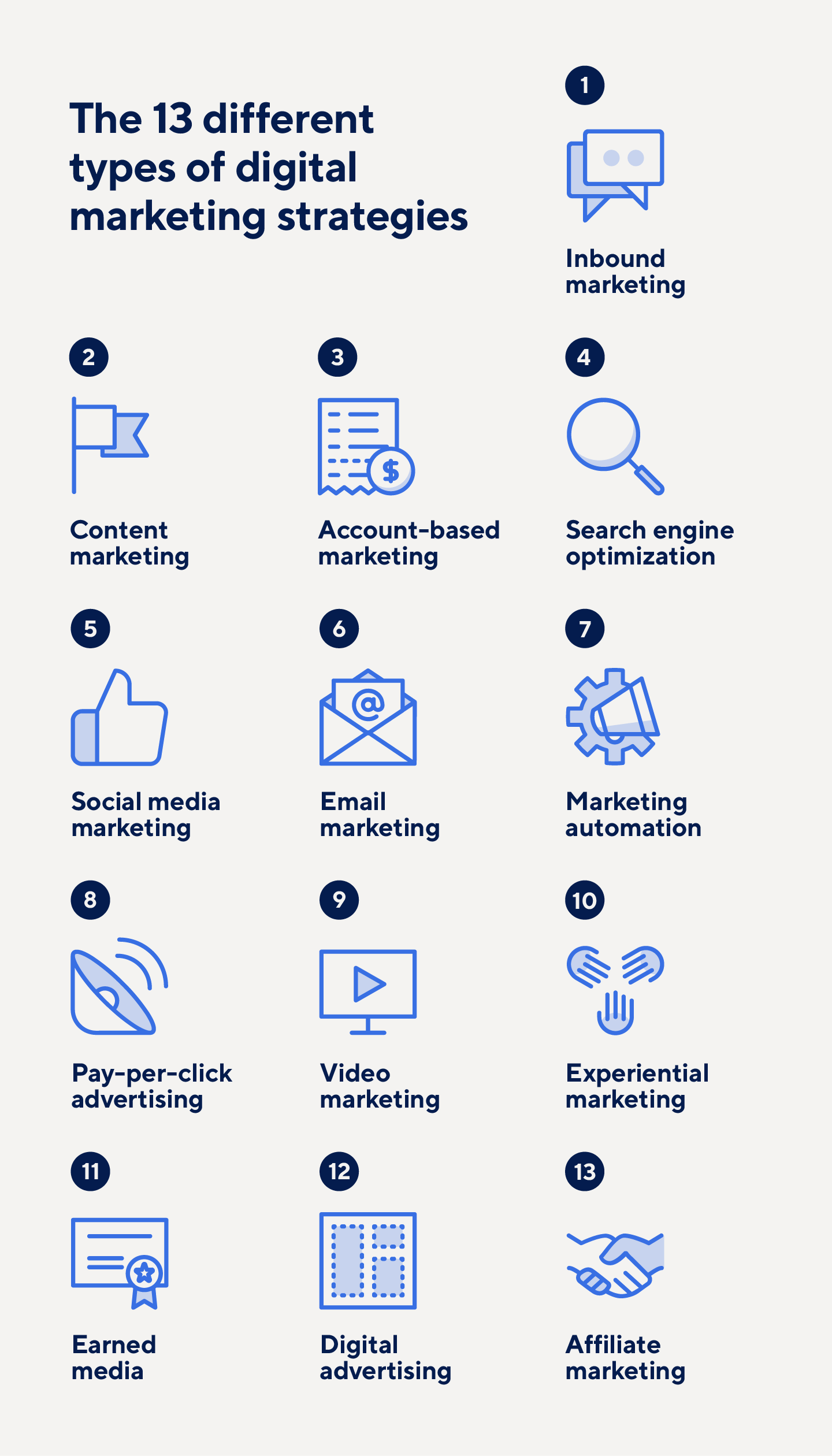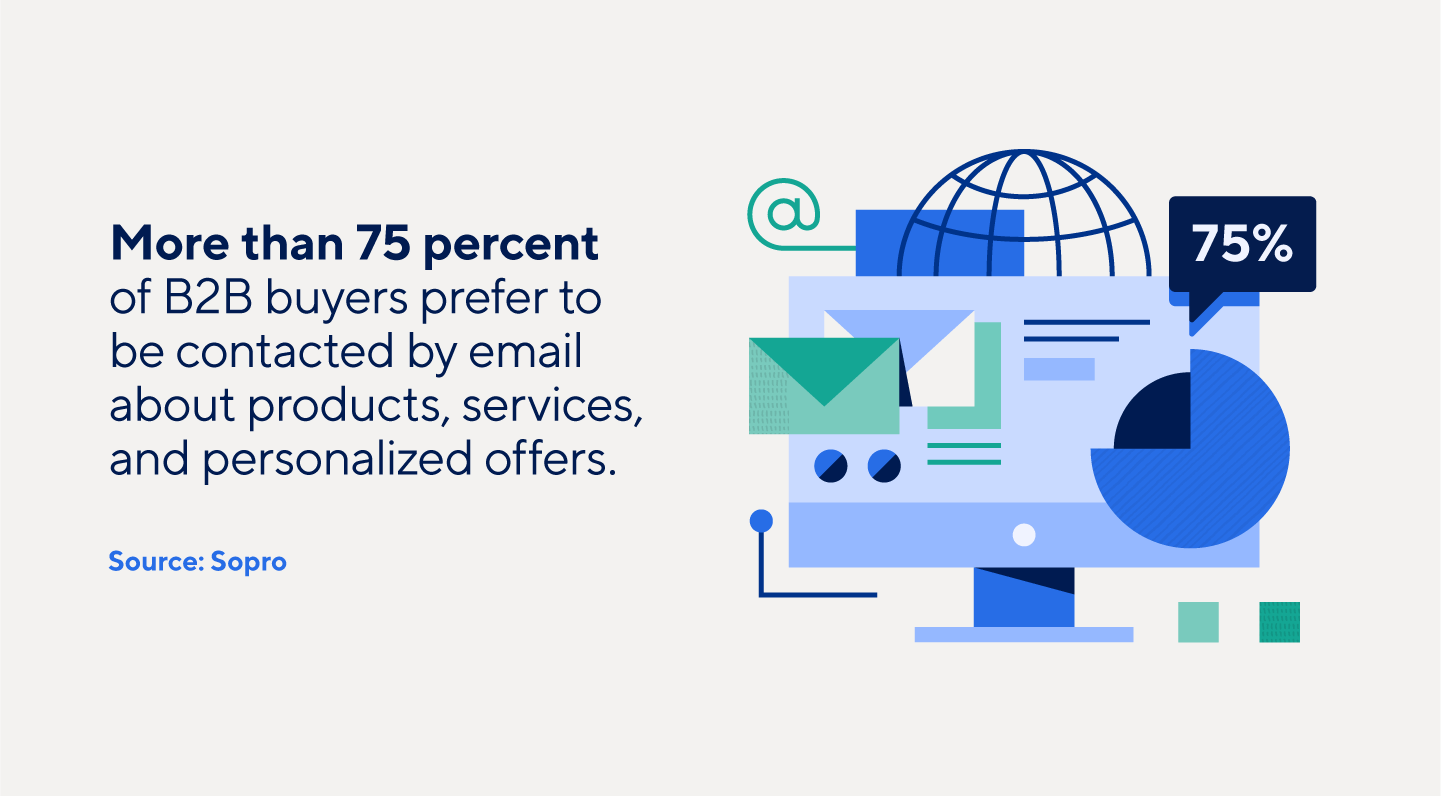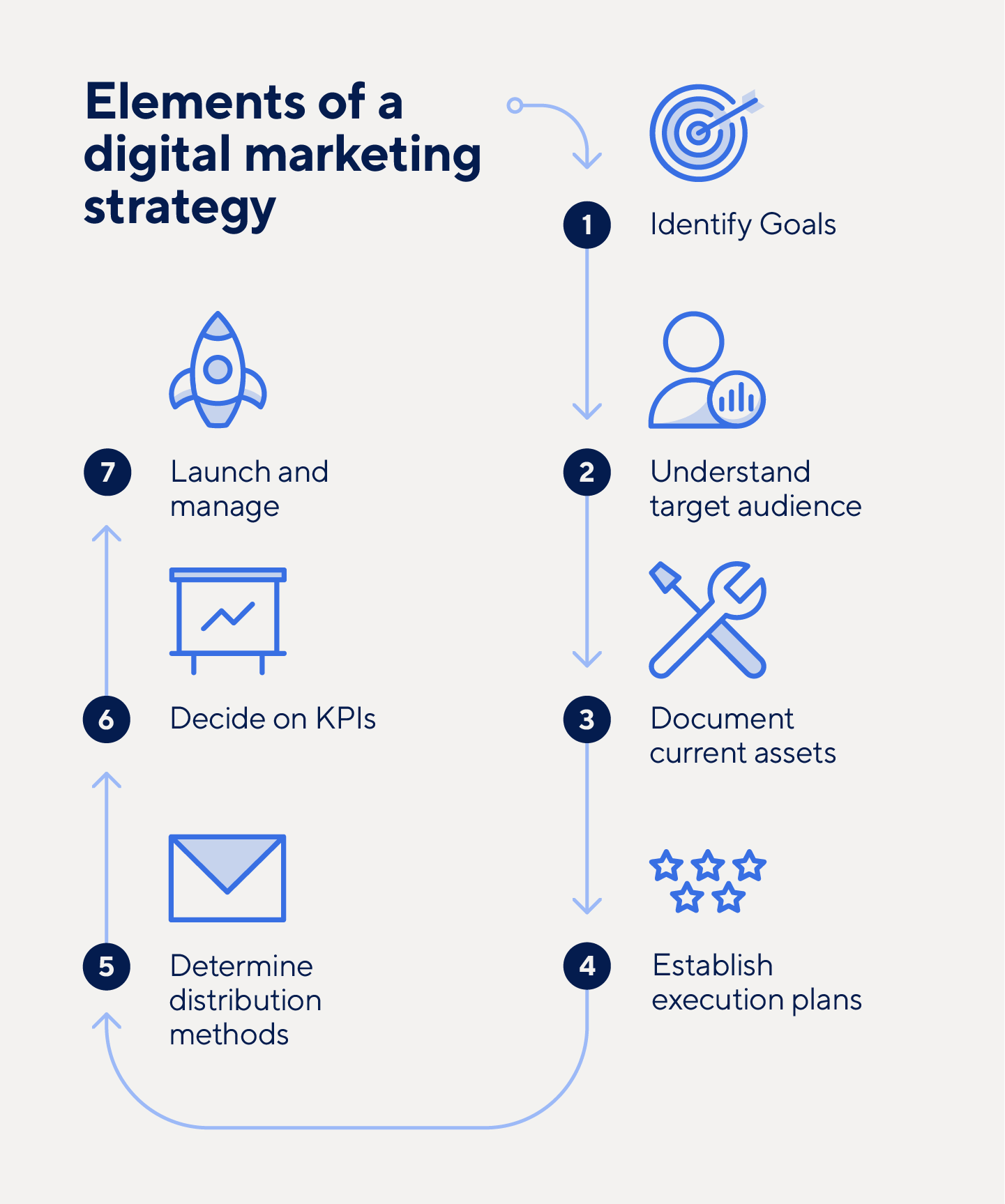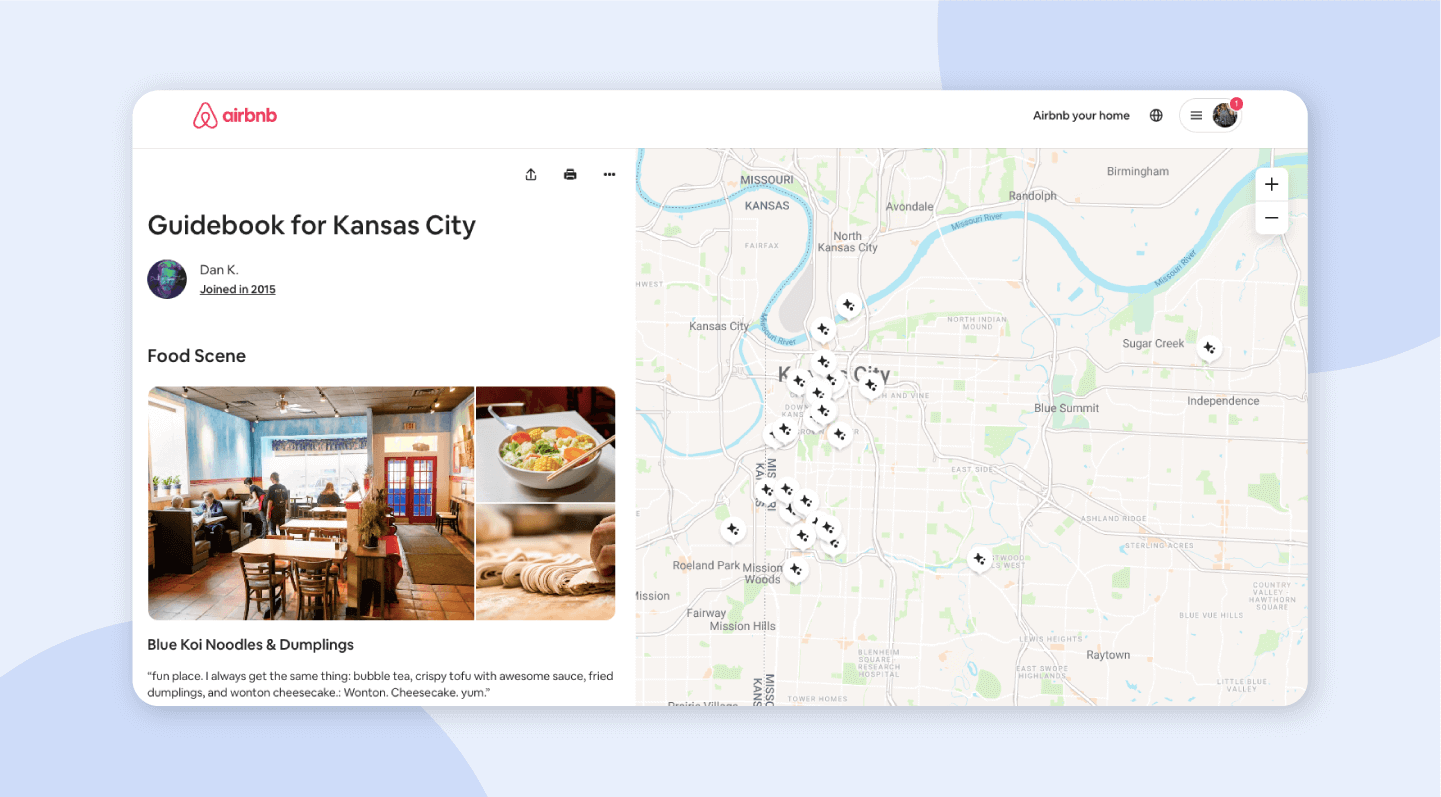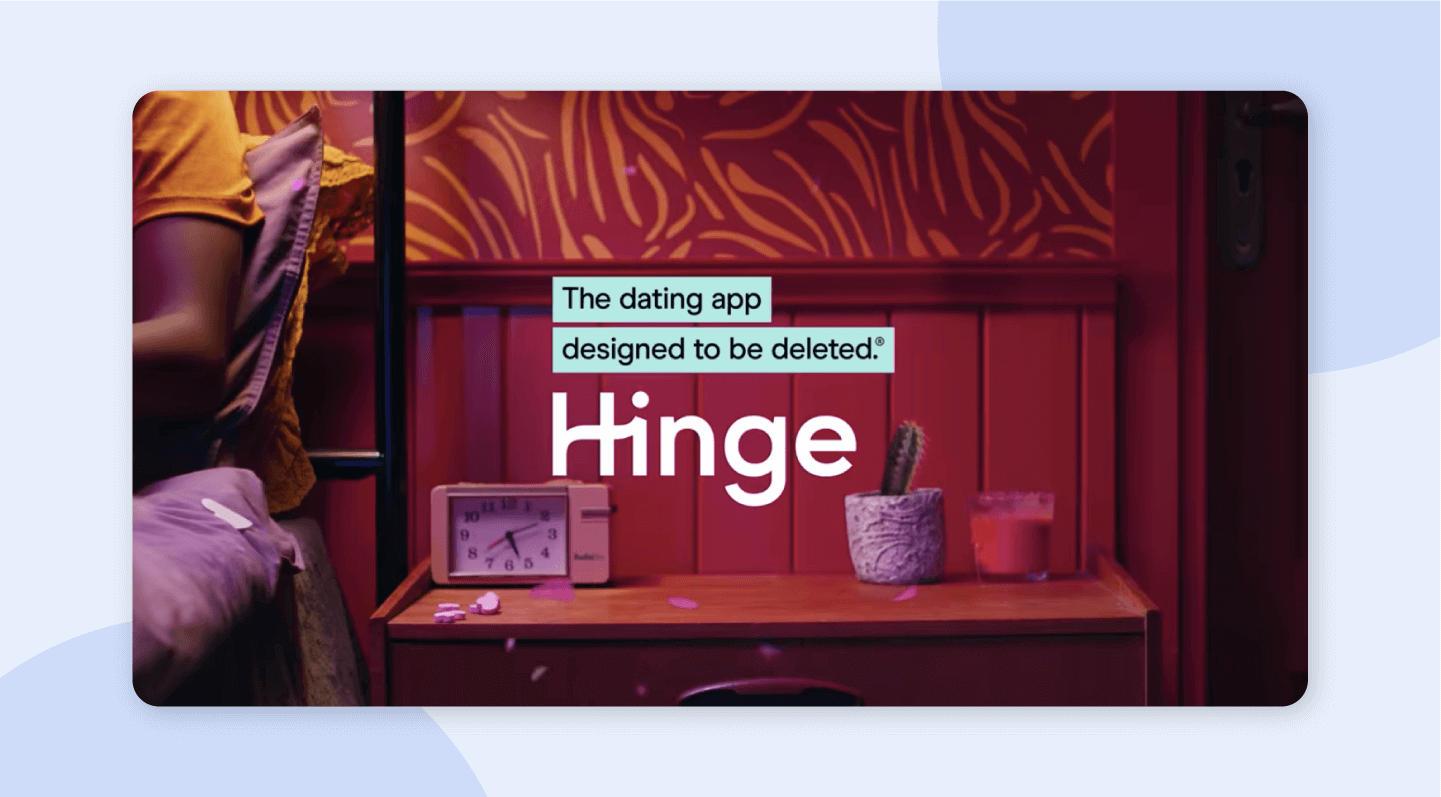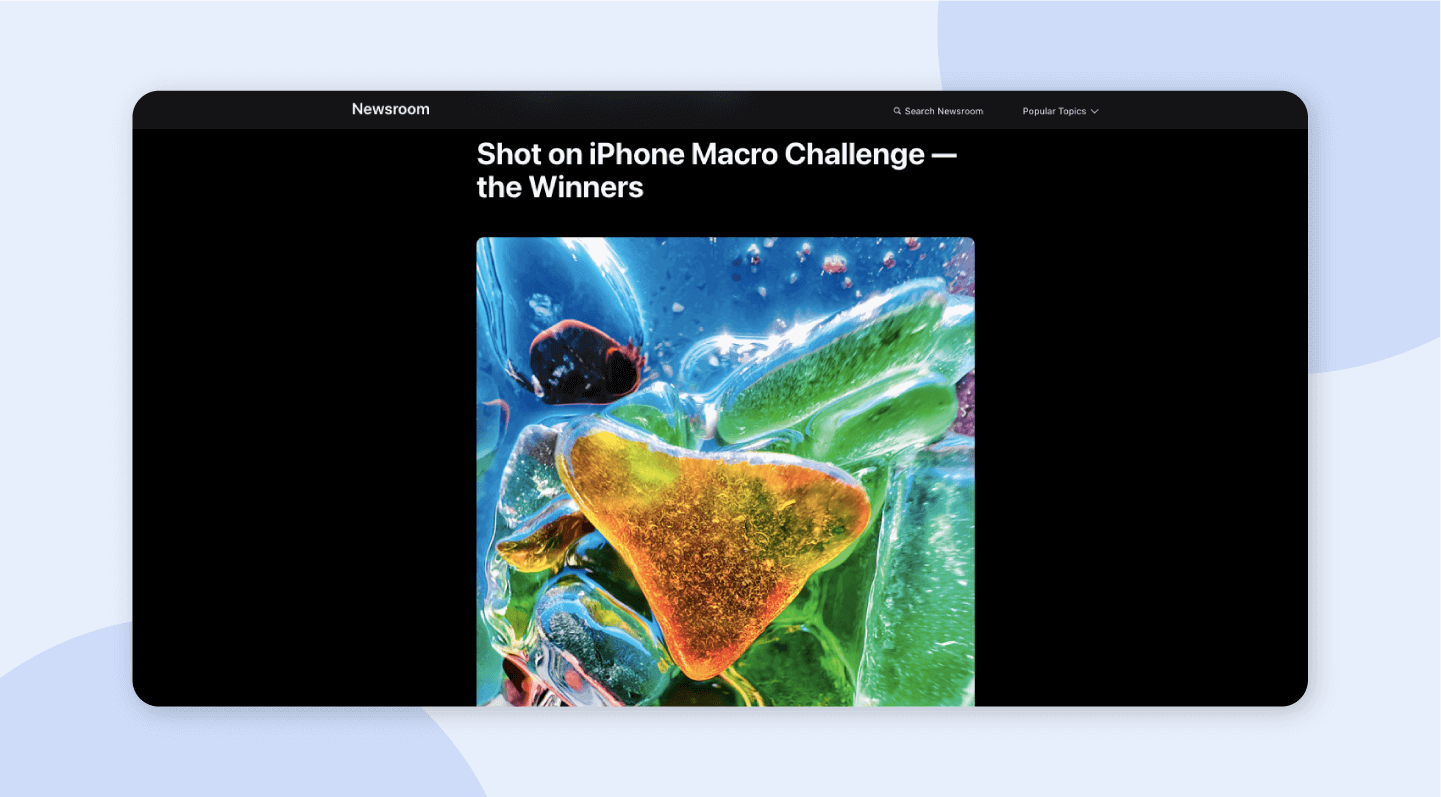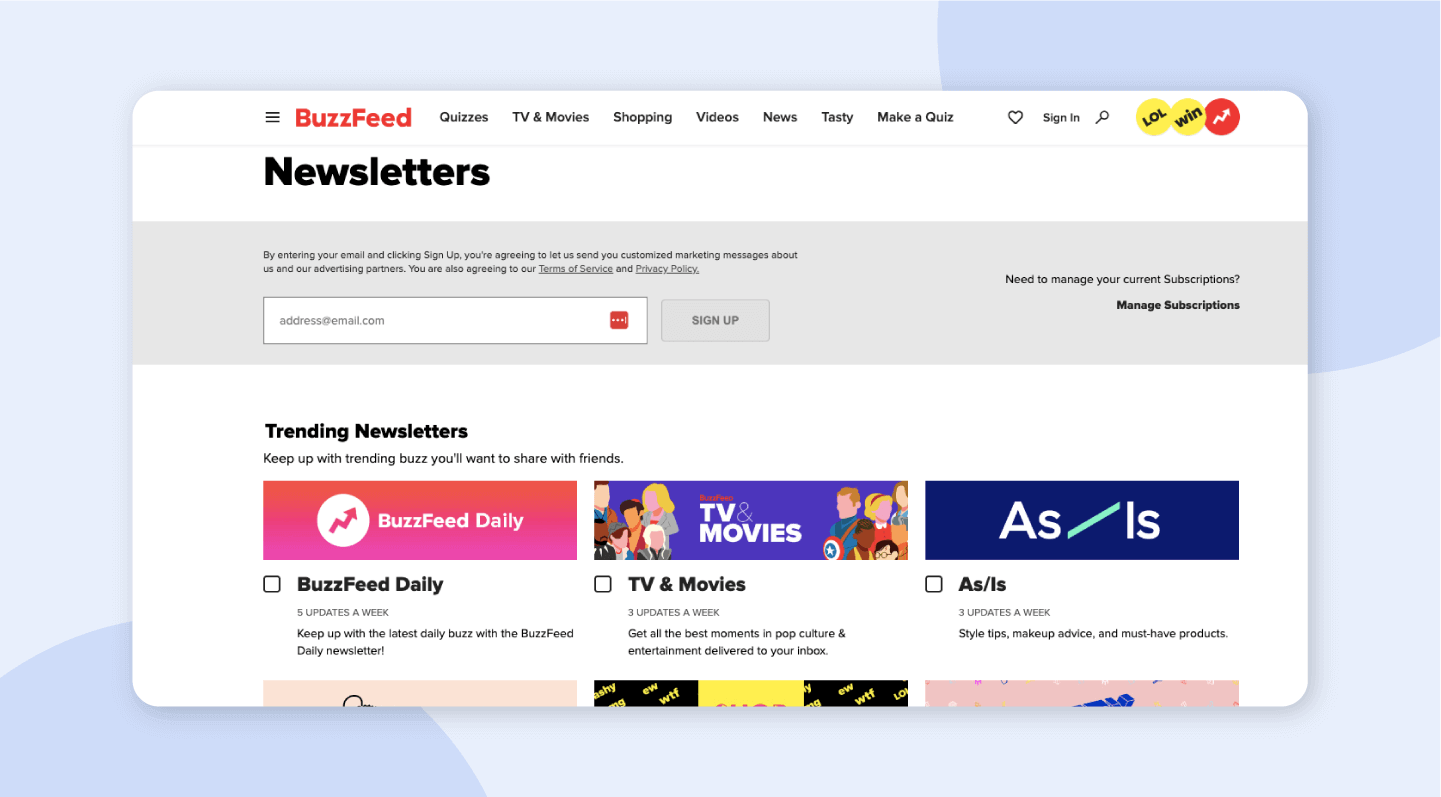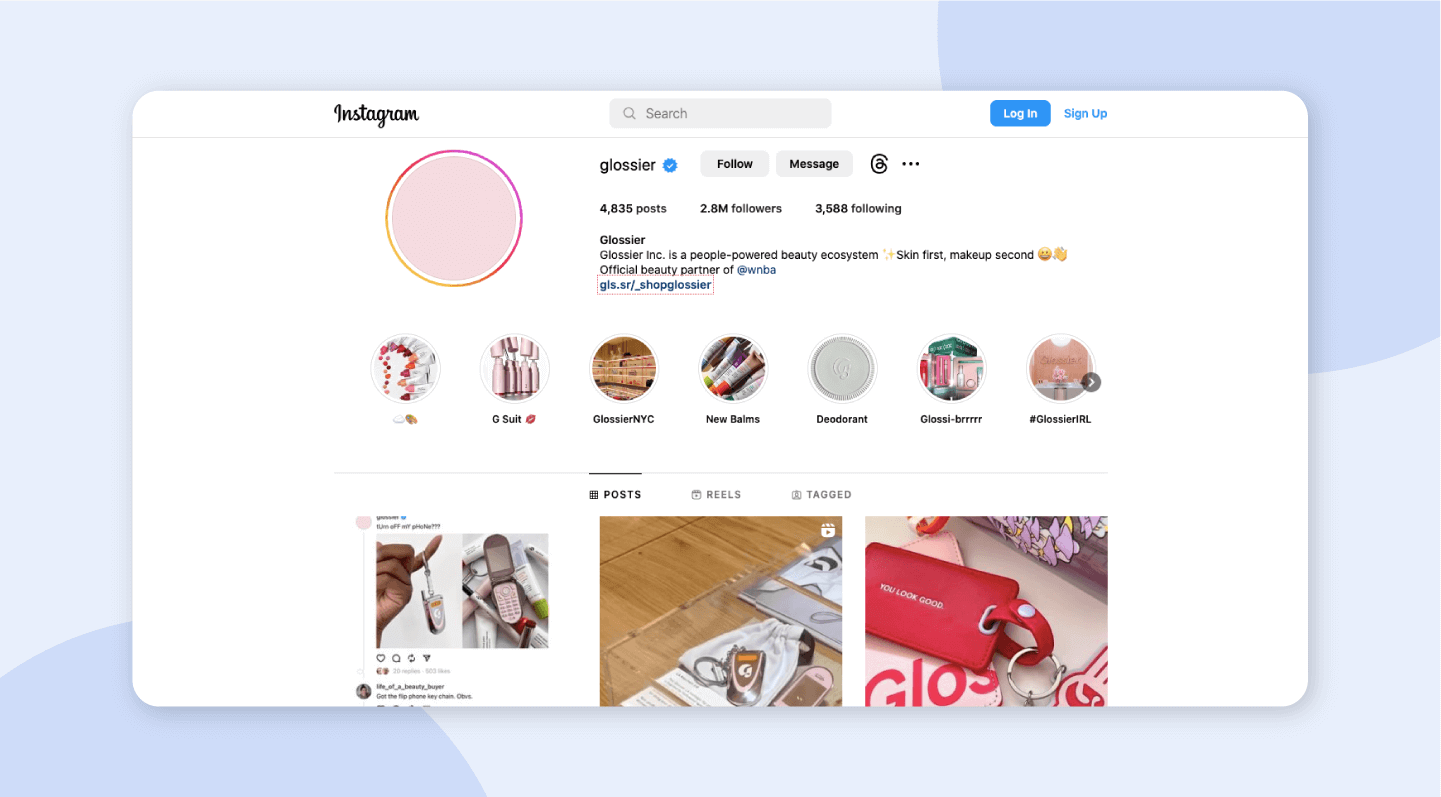What Is a Digital Marketing Strategy?
A digital marketing strategy is a tactical marketing plan designed to help a brand reach specific product and business goals related to the digital realm. After identifying your goals during the marketing process, you can determine the campaigns and tactics involved in achieving those goals, and develop a digital strategy accordingly.
As the name suggests, a digital marketing strategy uses online tactics to reach certain goals. A digital strategy can help brands reach a larger audience, convert online consumers, and increase website traffic.
Staying top of mind is a concern for many brands in a saturated market, but digital marketing strategies can increase:
- Strategic Advantage: Increased marketing innovation and online promotion can give brands a competitive advantage.
- Relevance: Evolving with the ever-changing digital world allows companies to grow alongside their target audience.
- Exposure: An online presence across various platforms can increase exposure and grow brand awareness.
Strategy vs. Tactics
Brands use marketing tactics to successfully launch, implement, and improve a comprehensive digital strategy. Strategies help marketers define overarching goals, while tactics are the actions marketers take to reach the goals defined by their strategy, and move brands toward success.
A marketing strategy can utilize a variety of tactics, including the following:
- Blog Posts: Well-written and well-researched blogs can support thought leadership, increase product and service promotion, and drive conversions.
- Customer Communication: Managing customer relationships across platforms can help brands strengthen loyalty and trust.
- Advertisements: Strategic promotions can increase brand awareness and product conversions.
- Website Updates: UX considerations can increase audience engagement and loyalty.
Strategy vs. Campaign
Marketing strategies and campaigns go hand in hand — one is needed to support the other. While a digital marketing strategy determines a brand’s high-level goals and objectives, a campaign focuses on promoting and reaching a single goal within a strategy.
Campaigns are usually time-bound and can use unique tactics to succeed. A brand may launch several campaigns targeting different individual goals at the same time, and track the progress of each campaign separately.
A marketing strategy can utilize a variety of campaigns, like the following:
- Email Campaigns: Send unique and personalized emails to past, present, and future customers, encouraging them to interact with or purchase from your brand.
- Ad Campaigns: Create distinct messages to promote audience action and reach business goals.
- Brand Awareness Campaigns: Advertise new and updated products to target audiences and encourage engagement.
13 Types of Digital Marketing Strategies
Every type of digital marketing strategy is customizable and delivers individualized results. Some strategies are designed specifically for particular goals and objectives, so choose your digital marketing plan carefully and be ready to adjust your strategy according to your needs.
1. Inbound Marketing
Inbound marketing is an umbrella term for the customer acquisition and conversion process. Like other types of digital marketing strategies, it uses various campaigns and tactics to reach long-term goals, and it is typically active alongside other, more specific strategies.
Many marketers use inbound marketing for the following reasons:
- It’s affordable: Specific targeting over longer periods of time can produce a greater ROI.
- It’s trustworthy: Long-term tactics, including blog and content creation, can increase expertise and brand loyalty by answering customer questions and addressing concerns.
- It’s relationship-centric: High-quality content and customer-centric marketing approaches nurture relationships and encourage repeat customers.
2. Content Marketing
Content marketing aims to answer queries quickly and succinctly without unwanted advertisements, inaccurate information, or ineffective user experiences. A content strategy can include blog posts, landing pages, videos, copy-based digital assets, white papers, and other tactics.
You can create content marketing for every stage of the buyer’s journey, increasing brand awareness, loyalty, trust, and expertise. Plus, content marketing is usually:
- Optimized: It prioritizes SEO and user experience to help customers move through pages, answer questions, and make decisions.
- Authoritative: Consistent, well-researched content with detailed responses about consumer needs can position brands as industry leaders.
- Relational: Brands that continuously release content and keep their audiences engaged by prioritizing their needs can build strong relationships.
3. Account-Based Marketing
The buyer’s journey can be long, and account-based marketing (ABM) is designed to speed up the process between interest and purchase. With this digital marketing strategy, marketers and salespeople work together to create campaigns targeted at specific audiences — usually those who have brand loyalty and offer a high potential ROI.
Additionally, marketers may choose to use account-based marketing for the following reasons:
- It’s personal: Buyer personas can be used to inform marketing campaigns and ensure all tactics include personalized messaging.
- It’s collaborative: ABM requires marketing and sales teams to effectively work together to create campaigns designed for unique audiences.
- It’s efficient: It allows you to create specialized content for individual customers, guiding them to the end of the sales process simultaneously.
4. Search Engine Optimization
Search engine optimization (SEO) aims to enhance content so it answers user queries quickly and accurately, which can improve search engine rankings, organic traffic, and, eventually, conversions. A comprehensive SEO checklist can help marketers prioritize certain tactics, including keyword optimization and user experience improvements.
Plus, SEO can increase the following:
- Conversions: Enhanced page loading speed, device compatibility, and user experience can positively impact conversion rates.
- Brand Awareness: Higher SERP rankings can help brands reach larger audiences.
- Cost Savings: Optimized content performs well for extended periods of time, which can increase organic traffic and click-throughs without added costs.
5. Social Media Marketing
Social media marketing strategies use platforms like Instagram, Facebook, YouTube, and TikTok to promote brands, announce new products, connect with customers, and encourage customer engagement. Social media strategy templates can help marketers determine ad spending, posting schedules, and platforms to prioritize.
Many marketing professionals incorporate social media marketing in their digital marketing strategy for the following reasons:
- It’s affordable: Most social media accounts are free, and effective ad spending can be fairly inexpensive.
- It’s interactive: Audience members can interact directly with brands by liking, sharing, commenting, reposting, and dueting.
- It increases brand loyalty: Positive online personas can impact customer loyalty, which can also help create authentic brand advocates.
6. Email Marketing
Most B2B customers prefer to be contacted by email — not by phone call, text, instant message, or any other communication method. Brands hoping to engage with customers and encourage conversions can use email marketing to provide in-depth product and service information, call-to-action (CTA) opportunities, and custom landing pages to interested buyers.
Avoiding the spam folder as a brand can be difficult. Still, it’s worth the time and effort, especially because email marketing is:
- Trackable: Most emails contain various links and CTAs, which can help marketers track key performance indicators (KPIs) like click-through rates and open rates.
- Cost-Effective: Even with investments in email automation software, email marketing is usually less expensive than other forms of customer communication.
- Targeted: Marketers can create unique, targeted messages for specific audiences at different stages of the buyer’s journey.
7. Marketing Automation
Many customers expect instant gratification, especially if they need answers to solve a problem. Marketing automation is a digital marketing strategy that attempts to satisfy these needs while still providing stellar brand experiences. Many brands have begun investing in chatbots and other AI technologies, along with streamlined automation software.
Marketing automation can improve the following:
- Customer Experiences: Customers receive prompt responses to questions and concerns.
- Engagement: Immediate responses can reduce wait times and keep audiences engaged during the early stages of the buyer’s journey.
- Efficiency: Customers can contact chatbots or receive welcome emails immediately, which keeps brands connected to their audience at all times.
8. Pay-Per-Click Advertising
Pay-per-click (PPC) advertising uses paid media to target specific terms and audience members. This strategy requires brands to pay each time a user selects an online ad, which is often displayed on search engine results pages (SERPs). Although the cost of PPC advertising differs between terms, brands can choose where consumers are directed once they click an ad.
If a brand is looking to increase sales, they may choose to implement PPC advertising because it is:
- Trackable: Many online ad programs track views, clicks, and conversions automatically.
- Controllable: Marketers can choose their spending limits and create custom landing pages for ad campaigns.
- Efficient: It’s possible for simple PPC advertising campaigns to deliver instant results.
9. Video Marketing
Video is the new blog post — almost all consumers report using videos to learn about a topic or learn a new skill, and 89 percent also say they are more willing to make a purchase after watching a product, service, informational, or advertisement video. When planning a video or video campaign, consider interviewing industry experts, producing how-to content, or recording positive customer reviews.
While videos are great for customer engagement, they can also improve:
- Optimization: The SERP frequently rewards video content, which means brands can optimize content by including accurate and helpful videos.
- Conversions: Landing page videos, social media videos, and other types of video content can encourage customers to move through the buyer’s journey.
- Brand Association: Video content can help keep brands top of mind and increase associations between brands and specific products.
10. Experiential Marketing
Experiential marketing covers various marketing tactics, including in-person events, livestreams, online contests and auctions, and other experiences and engagements available to a brand’s target audience. You can use this digital marketing strategy to promote a product, introduce a new service, launch a business, and more.
Experiential marketing boasts various benefits, including the following:
- Interactivity: In-person and online events encourage direct brand-to-consumer interaction.
- Product Showcases: Experiences and events designed for new and existing products may include demonstrations, which can encourage conversions.
- Flexibility: You can host experiences as livestreams, in-person events, social media contests, and more.
11. Earned Media
While PPC advertising can help you reach potential customers in your target audience, earned media can spread your net even wider. Earned media refers to any type of media coverage your brand receives that you didn’t pay for. It’s possible to reach out to public relations specialists and request brand coverage, but earned media can also be created organically by previous customers.
Marketers may invest time into an earned media approach because it is:
- Free: Earned media is free and will not cause a brand to incur any costs.
- Scalable: Brands of all sizes can request media coverage — from link reclamation and product reviews to site builds and surveys.
- Public: Earned media can increase trusted backlinks, which can help content reach new customers.
12. Digital Advertising
Similar to social media marketing, digital advertising uses online platforms to promote products and services. However, this digital marketing strategy utilizes unique channels — websites, streaming services, search engine results pages, third-party pages, and more — instead of typical social media platforms.
Additionally, digital advertising is often compared to print advertising, but it is more:
- Flexible: Online platforms are available to marketers at all hours of the day. Digital advertisements can be ideated, created, produced, and launched quickly.
- Precise: Digital ads are targeted to reach and be viewed by specific audiences instead of generalized groups of readers, viewers, and listeners.
- Trackable: A digital ad’s performance metrics can often be tracked in real time, which allows marketers to quickly adjust their strategy depending on online results.
13. Affiliate Marketing
Affiliate marketing is a form of collaboration marketing in which two entities agree to work together in exchange for a commission, exposure, or both. This digital marketing strategy can occur between brands, influencers, or other product users. Like earned media, affiliate marketing can occur without payment, but both parties must accept the agreement.
Once an agreement is reached, affiliate marketing can help with:
- Reach: Affiliate brands can promote products and services to another entity’s audience.
- Cost Savings: Affiliate marketing can produce a higher ROI than what the brands spend upfront on creating ads or collaborating.
- Sourcing: Brands may agree to outsource the content creation to their partner.
How To Create a Digital Marketing Strategy
After performing a SWOT analysis and analyzing your business’s assets, determine if creating a digital marketing strategy is the logical next step for your brand. If so, it’s time to establish your goals, understand your audience, and execute your plan from scratch — or you can use a marketing strategy template.
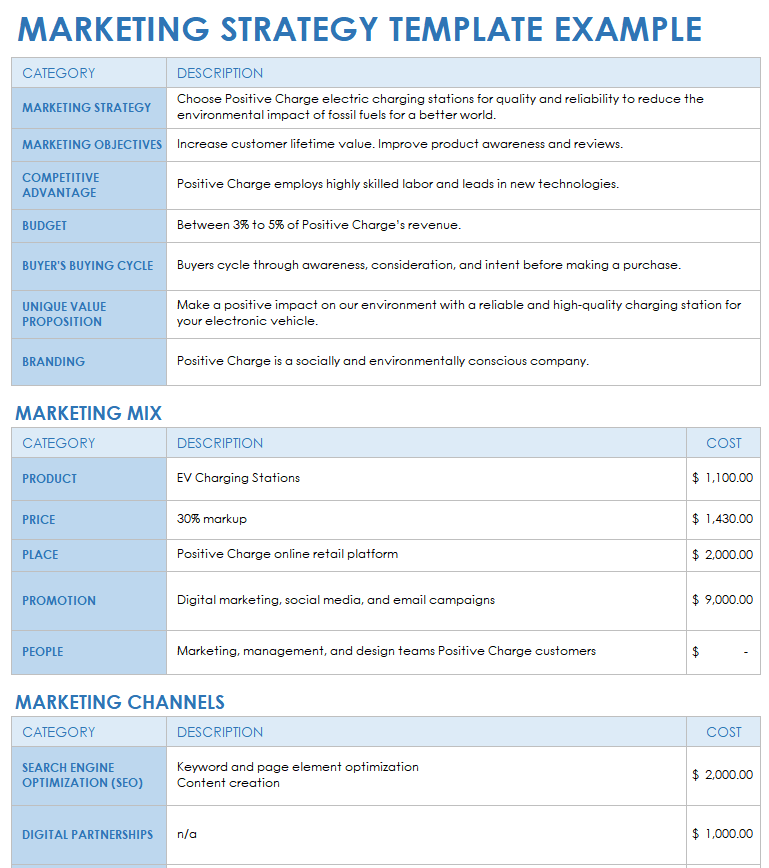
Download a Marketing Strategy Template with Sample Data for
Excel | Microsoft Word | Google Docs | Google Sheets
Download a Blank Marketing Strategy Template for
Excel | Microsoft Word | Google Docs | Google Sheets
Our marketing strategy template can help you establish and achieve digital marketing goals across various channels. This template also allows users to record pricing, assign ownership, and determine value propositions.
Step 1: Identify Goals
Different digital marketing strategies can help marketers reach goals over various timelines. Before choosing which type of strategy to use, assess and determine your company’s goals. Setting SMART goals that are specific, measurable, attainable, realistic, and time-bound can help you determine which strategy you should use to see marketing success
Step 2: Understand Your Target Audience
Your audience’s traits can help you determine key elements of a successful digital marketing strategy: the types of campaigns to create, which tactics to employ, and the length of time needed to reach specific goals. Consider building out data-backed buyer personas to better understand your audience.
To build a buyer persona, do the following:
- Consider where customers are located.
- Estimate their age range.
- Evaluate potential occupations and income levels for customers.
- Understand a group’s hobbies and interests.
- Create products or services that serve your audience’s wants, needs, and goals.
- Learn your audience’s pain points and weaknesses.
You can find this data by analyzing past and current customers and subscribers. Businesses can also target hyper-specific groups of potential customers by creating multiple buyer personas with specific wants, needs, interests, and demographics.
Step 3: Document Current Assets
Most brands don’t start from scratch when they create a digital marketing strategy. By analyzing, documenting, and rating your current assets, you can determine which digital marketing tools you already utilize and which you need to invest in. Document every digital asset your brand uses and identify where tools could be merged, integrated, separated, or removed.
Step 4: Establish Execution Plans
After identifying your current assets, it’s time to decide what you need to create. You can schedule and assign a strategy’s unique tactics using a digital marketing plan that takes into consideration:
- Budget: Marketers must determine a full strategy budget, which can be broken down and assigned to individual assets.
- Time: Each tactic and campaign uses different timelines to meet specific deadlines.
- Resources: The types of resources — including people and technology — needed to successfully complete a project can impact timelines, budgeting, and execution.
These considerations go hand in hand with a brand’s goals, influencing how an organization reaches its target audience and invests in digital assets.
Step 5: Determine Distribution Methods
If your company creates top-tier content but doesn’t strategize how to distribute it, it’s useless. Your target audience and buyer personas can help determine the best channels to use when distributing content.
Common distribution methods include:
- Owned Channels: Owned channels belong to your brand and can include platforms like websites, blogs, and social media profiles. In this method, you determine what, when, and how content is distributed.
- Earned Channels: Earned channels refer to platforms or content owned and controlled by third parties. Earned media, which brands don’t pay for, can include social media shares, reposts, reviews, comments, and more.
- Paid Channels: If you use paid channels to distribute content, you will pay for the content to be produced outside of your owned and earned channels. This method offers users limited control and can include pay-per-click content, influencer marketing, and other collaboration deals.
Many brands will use owned, earned, and paid distribution methods in tandem to reach larger audiences and control certain channels.
Step 6: Decide on KPIs
To determine if your digital marketing strategy is successful, you need to monitor key performance indicators (KPIs). These metrics help marketers evaluate the success of their strategies and campaigns and provide insights into a brand’s goal progress.
Common marketing KPIs include:
- Conversion rates
- Click-through rates
- Website traffic
- Social media traffic
- Customer acquisition cost
With certain marketing software, KPIs can be measured and analyzed automatically. After launching a strategy or campaign, these metrics can help marketers make informed marketing and content decisions.
Step 7: Launch and Manage
After setting up the components of your digital marketing strategy, you’re finally ready to launch. Using the results of a brand’s chosen KPIs, marketers can continuously manage a strategy and its unique campaigns and tactics. During this stage, marketers can also focus on personalization — customer feedback surveys can provide real-time responses about the effectiveness of their digital marketing strategy.
Digital Marketing Strategy Best Practices
Just like technology, digital marketing is constantly changing. To create strong, successful digital marketing strategies, it’s important to follow some universal best practices:
- Create Quality Content: Keep your target audience’s wants and needs top of mind by creating content that quickly and accurately answers questions, provides solutions, or presents well-researched information.
- Leverage Expertise: Focus on queries your brand is an expert on. Don’t be afraid to source quotes from other professionals or collaborate with other brands.
- Complete Competitive Analyses: All brands have competitors. Don’t ignore the content they’re creating or the campaigns they’re running — instead, study their product and service strategies to understand their audiences, too.
- Follow Industry Updates: Subscribe to expert blogs and newsletters to stay up to date on industry trends and changes so you’re prepared to answer industry-specific questions and address potential concerns.
Digital Marketing Strategy Examples
Check out these examples if you need inspiration for planning and launching your brand’s digital marketing strategy.
Airbnb
Type of Strategy: Earned media
When it comes to digital experiences — including advertisements and informational content — 71 percent of consumers prefer personalized experiences. As a large online marketplace connecting people to thousands of travel destinations, affordable rental properties, and one-of-a-kind experiences, Airbnb knows the power of user-generated content. The company’s host guidebooks, curated by local individuals, provide travelers and community members alike with unique opportunities to explore nearby neighborhoods and faraway cities.
Hinge
Type of Strategy: Social media marketing
Most brands don’t encourage their customers to delete or throw away their products, but Hinge isn’t like most brands. With the tagline “The dating app designed to be deleted,” Hinge took its out-of-the-box thinking and created a singular digital marketing strategy. By understanding its target audience — young adults looking for long-term relationships — it launched campaigns on TikTok and YouTube and gained more than 142 million digital impressions across all platforms.
Apple
Type of Strategy: Earned media and experiential marketing
#ShotoniPhone was Apple’s digital marketing strategy designed to showcase the newest camera technology on the iPhone 13 Pro and the iPhone 13 Pro Max. The strategy included a social media contest where 10 photos were chosen to be displayed across Apple’s social media platforms, website, and billboards. With high-quality images created by the brand’s newest technology, Apple was able to source thousands of campaign-worthy images from users of all backgrounds.
BuzzFeed
Type of Strategy: Email marketing
Email marketing is not dying — in fact, a majority of marketers have seen an increase in email engagement within the last year. BuzzFeed, with its multiple hyper-specific newsletter options with clickable internal assets, knows how to create curated content for unique buyer personas. With recipes, travel tips, news feeds, and more, consumers can quickly and easily decide the type of content they want to receive, the frequency of emails, and whether or not the content is worth engaging with.
Glossier
Type of Strategy: Social media marketing
With almost three million Instagram followers, Glossier knows how to leverage social media as a digital marketing strategy. Before the brand launched a single product, its social media following had grown to well over 10,000 users — personality and realism is the name, and Glossier knows how to play the game. Instead of creating aesthetic, social media-worthy photos, the brand staged actual products with real customers doing everyday activities, which helped establish Glossier as approachable and desirable.
The best marketing teams know the importance of effective campaign management, consistent creative operations, and powerful event logistics -- and Smartsheet helps you deliver on all three so you can be more effective and achieve more.
The Smartsheet platform makes it easy to plan, capture, manage, and report on work from anywhere, helping your team be more effective and get more done. Report on key metrics and get real-time visibility into work as it happens with roll-up reports, dashboards, and automated workflows built to keep your team connected and informed.
When teams have clarity into the work getting done, there’s no telling how much more they can accomplish in the same amount of time. Try Smartsheet for free, today.
